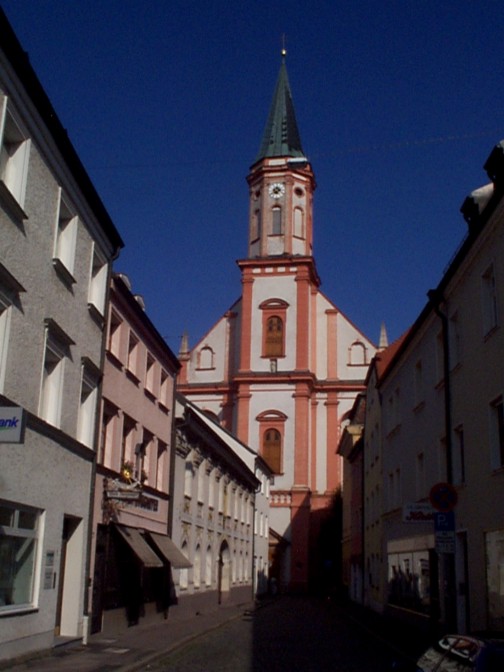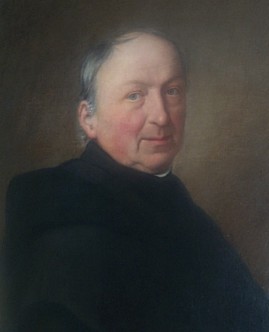|

no. 1 january - march 2003
 |
|
CELEBRATION OF THE 200th
ANNIVERSARY OF THE REOPENING OF THE MONASTERY IN STRAUBING |
| |
|
|
|
German monastery is
the oldest in world with continuous Carmelite presence |
The former Archbishop,
Dr. Karl Braun of Bamberg, celebrated the anniversary of the Straubing
Carmelite Church together with numerous guests of honor and many laity.
In his homily, the
Archbishop said “God often writes straight with crooked lines.” God did so
in the 19th century. After the so-called “Secularization” and
the hostile actions against the Catholic Church, new religious centers
were established.
Looking to the future,
the Archbishop underlined the need to be faithful to one charism and at
the same time to offer oneself for the good of humanity. “The Carmelite charism will remain alive. The future does not develop by itself,
following nature’s laws. It needs the human input. The history of your
monastery shows this. God is still good for surprises!”
Following the Eucharist,
Professor Karl Hausberger, of the University of Regensburg, gave a talk on
the secularization and reopening of the Carmelite monastery.
life of the Catholic monasteries was very much part of the
government’s policy. Such interference also occurred in the mendicant
Orders. The ecclesial-political situation had changed following the French
Revolution in 1789. Already by 1796, Maximilian Joseph Freiherr von
Montgelas asked for the abolition of the mendicant houses.
All means were used to
reduce the number of people involved in the monasteries. The few religious
who remained received the minimal pension possible and remained enclosed
in centralized monasteries.
Straubing was chosen as
the central monastery of the Order in Old-Bavaria. By 1801, the Carmelites
had given all their gold and silver valuables to the war effort. By mid
July 1802, the members of the community lost their right to work and the
monastery was sequestered. Any incoming money was taken by the State. The
few remaining members petitioned more than once for government help.
The population of
Straubing and the local government, however, gave support to the
Carmelites. In the Summer of 1803, the civil schools were moved to the
Carmelite monastery and by the end of the year a large part of the school
for older children was also located there.
 |
|

(Above) Painting of Fr. Peter Heitzer,
O. Carm., "prior zelosissimus, conservator et restaurator" of
Straubing. The painting hangs in the dining room of the Straubing
monastery.
(Left) The Carmelite church of
Straubing
(CITOC Photos 2002)
|
Eight priests were in
Straubing in 1816. By 1830, only two priest remained. Fr. Peter Heitzer,
O. Carm., had been the prior since 1815. Fr. Heitzer was a native of
Straubing and the last to have entered before the Secularization. After
1830, he was the lone occupant of the Straubing monastery.
With Ludwig I’s
coronation in October 1825, the politics of the government dramatically
changed. Ludwig was a religious man and the relationship between the
government and the Church changed accordingly.
On August 14, 1826, Fr.
Heitzer petitioned that the Carmelite monastery in Straubing be reopened.
As there were no funds to pay for the necessary maintenance of the
cloister, the request was refused. A second request in 1830 was also
refused.
After a parish priest
left his money to the Carmelites of Straubing in his will, a fund was set
up for the maintenance of the monastery. This spurred the parish priest of
St. Jakob and St. Peter in Straubing to petition the King again.
On December 10, 1840, a
local lawyer and member of the City Council, Dr. Hölzl presented yet
another petition for the reopening of the monastery to the King. The
lawyer argued that there had been a strong connection between the
Carmelites and the House of Wittelsbach in the later Middle Ages he
pointed out that the tombs of Dukes Albrecht and Ernst were located in the
Carmelite church.
Dr. Hausberger commented,
“The astute preparation that touched upon the history of King Ludwig’s own
family brought the desired results.” On June 19, 1841, the King conceded
the reopening of the Carmelite house in Straubing.
On July 20, 1842, Bishop
Valentine von Riedel opened the Kloster in the presence of the
“Stadtkommissars” (City Commission) as the representatives of the
government. For Fr. Peter Heitzer, who had worked tirelessly to restore
the Straubing Karmel, only a few years of life remained. He died on
February 15, 1847. The large funeral gave testimony to his good reputation
and to the merits he earned during his exemplary life in Straubing.
“All in all, the
‘Secularization’ cannot be declared a moment of honor in the history of
Bavaria and of Germany,” declared Hausberger. The possibility of a rebirth
for many of the monasteries in Baveria, within the decade of the ‘monastic
springtime,’ was possible only because Ludwig I sense of history.
In his words of welcome,
the Oberbürgermeister (Mayor) of Straubing, Reinhold Perlak, emphasized
the traditional connection between the city and the Carmelite monastery.
He acknowledged that the testimony and the works of the Carmelites of
Straubing since1368 have been notable. “Straubing has received much from
the Carmelites.”
Summary from the Provincial
Bulletin of the Upper German Province
October
19, 2002
WEBSITE FOR THE GERMAN PROVINCES
|